19 Best Sauces For Meatballs, Besides Marinara
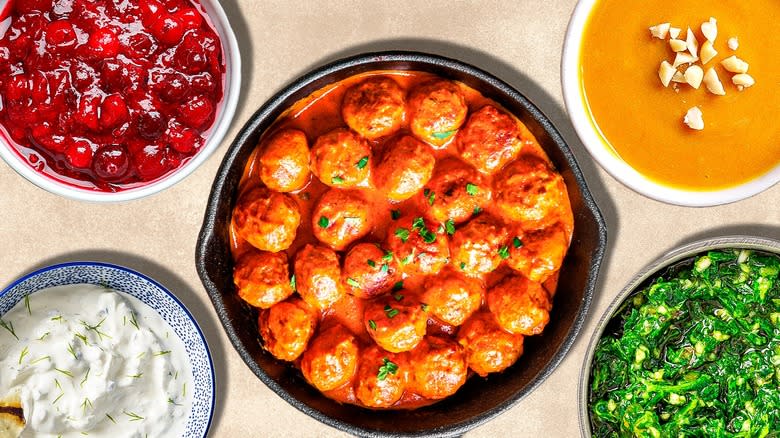
Meatballs are one of the most widespread dishes across the globe. Although different cultures around the world have their own interpretations of the meatball, it's clear that the one that comes to mind for most is the Italian meatball -- which is served coated in a copious amount of marinara sauce. There's nothing wrong with these classic meatballs and the sauce that often goes with them, but it's clear that the pervasiveness of this pairing has caused other equally (if not more) delicious sauces to slip through the cracks.
Frankly, there are some sauces out there that are just more flavorful and versatile in the world of meatballs than a simple tomato sauce. We've cultivated a list of some of the best sauces that you can serve with your meatballs to add an extra dimension of flavor and texture -- that aren't just ho-hum marinara. Some are better suited for certain proteins, like lamb or plant-based balls, while others are more universal.
Read more: 26 Types Of Pasta Sauce Explained
Pesto
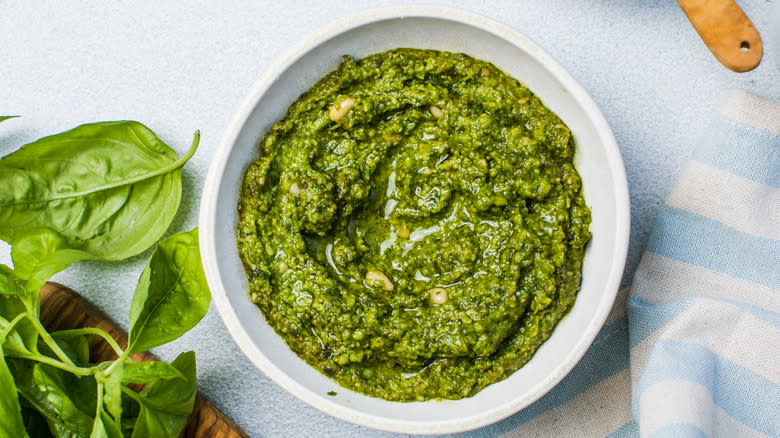
Pesto is one of those unapologetic sauces that always manages to get the short end of the stick. Not only is it a great summery spread for your favorite pasta shape, but you can also get creative with ingredients you add to it to make it all your own. Start with a traditional bright and fresh pesto made with the classic ingredients like basil, good olive oil, lemon juice, garlic, and pine nuts, or get creative and add a handful of spinach or kale to your herbaceous sauce.
Meatballs really crave the freshness that pesto can offer, which makes the two a perfect pairing. Our spiced lamb meatballs with green raisin pesto recipe brings mint, parsley, golden raisins, and grated lemon to the party to contrast the fatty richness of the cumin and coriander-spiced lamb. You can use pesto as a sauce for poultry or red meat-based meatballs, too.
Cacio E Pepe
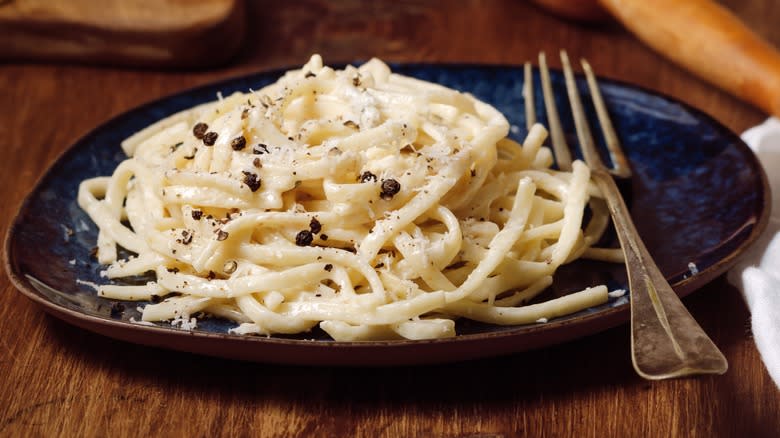
Cacio e pepe may have had its heyday around 2017, but we are glad to see that this sauce is making a comeback in the contemporary pasta lexicon. It's made with a few very simple ingredients, including pecorino romano cheese, toasted freshly ground peppercorns, and the reserved pasta water.
Cacio e pepe is a common sauce for a variety of noodles, but you can adapt it to suit your meatball recipe, too. The fresh peppercorns add a little bit of a bite to the meatball, while the sharp flavor of the cheese melds with any other spices or savory ingredients you have in your meatballs. As expected (and in an effort to stick with the Italian tradition), beef or veal meatballs are an excellent pairing for this rich and deceptively simple sauce.
Barbecue Sauce
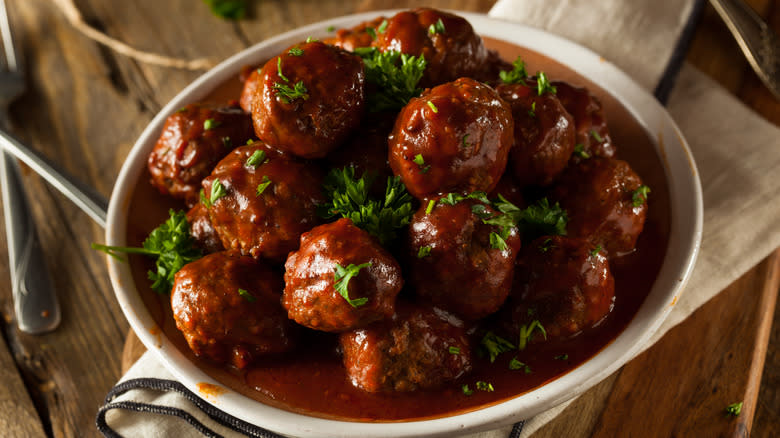
Barbecue sauce is yet another condiment that gets discounted. If anything, it gets used as a glaze for succulent pulled pork or ribs more than it's valued as a sauce for other dishes. One particular instance where barbecue sauce can really shine is as an accompaniment to meatballs -- especially when pork is involved.
The key to making barbecue meatballs at home is to add extra oomph to your sauce with other ingredients. Your favorite barbecue sauce, filled with mesquite or hickory notes, is a great start. But, adding an extra squeeze of ketchup or swirling in some Worcestershire sauce can give it an unexpected edge and send it to the next level. These saucy meatballs are a great party appetizer, or you can serve them alongside your favorite starch for a hearty dinner.
Cranberry Sauce
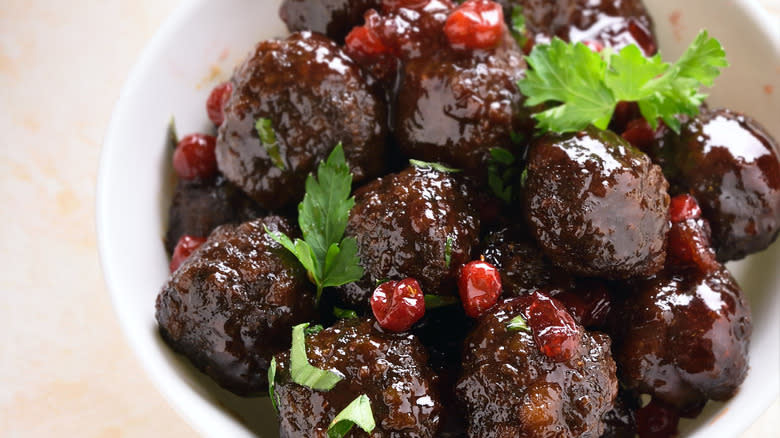
Wait a minute -- it's not Thanksgiving! Well, any day can certainly feel like Thanksgiving when you have a can of cranberry sauce. This canned condiment surely shines around the holiday, but it can be used for more than just a side to your mashed potatoes and turkey drumstick.
The cranberries introduce extra sweetness into the meatballs and can round out the entire profile of your protein. You'll want to leave the canned jelly in the pantry aisle, though, and opt for one with a jammier consistency. You can also DIY your own sauce for cranberry meatballs by reducing down the fruit with orange juice, sugar, and seasonings. We recommend using this sauce for standard beef and pork meatballs, or opting for a poultry-based recipe instead.
Arrabbiata Sauce
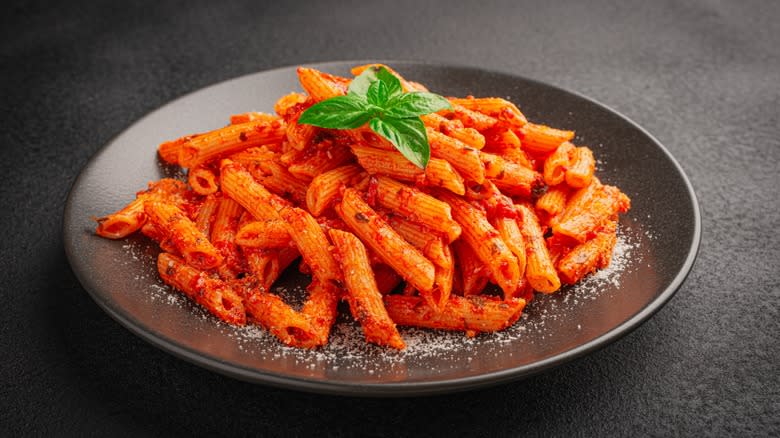
Arrabbiata is kind of like marinara's spicy, sultry cousin. It gets its iconic spice from red pepper flakes, but otherwise, it shares many of the same ingredients as a classic marinara sauce -- like tomatoes, Italian seasoning, and basil. The flavor hits the back of your throat after you take a bite or two, which makes it a more creative way to add heat to your otherwise one-note meatballs.
The best thing about making an arrabbiata sauce at home is that you can control the heat by adding more or fewer red pepper flakes to the mix. You can also customize the sauce by adding a splash of red wine (which would highlight a beef meatball particularly well) or combining it with a neutral cream sauce for a more unctuous and thicker version of the classic recipe.
Tzatziki
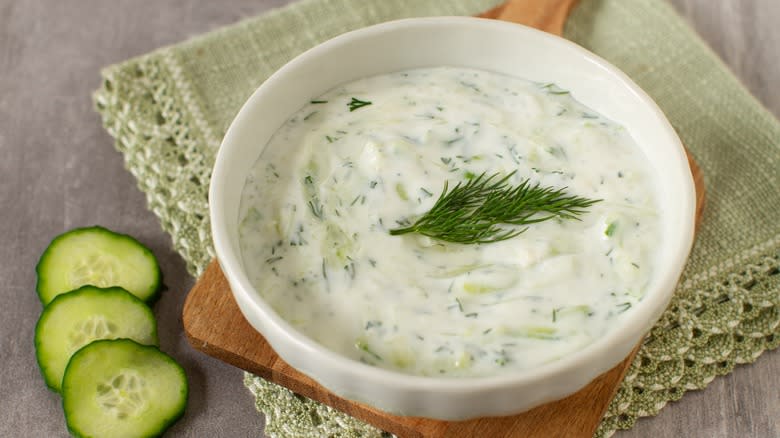
Tzatziki sauce is like the breath of fresh air that all dishes need, whether they're from the Mediterranean region or not. Not only do we always keep a container of tzatziki on hand for dipping crudités into, but we also use it as a spread for crackers or as a creamy salad dressing.
This condiment, for the uninitiated, is made with Greek yogurt, herbs, lemon juice, and cucumber. Unlike some meatball sauces, it's remarkably fresh and light, which can really elevate your protein to a new level. We love eating meatballs with tzatziki tucked into a pita pocket, since each bite is more focused on the meatball itself rather than the heavy roll that often accompanies meatball sandwiches. The freshness of the tzatziki is best suited for lamb or vegetable-based meatballs.
Chimichurri
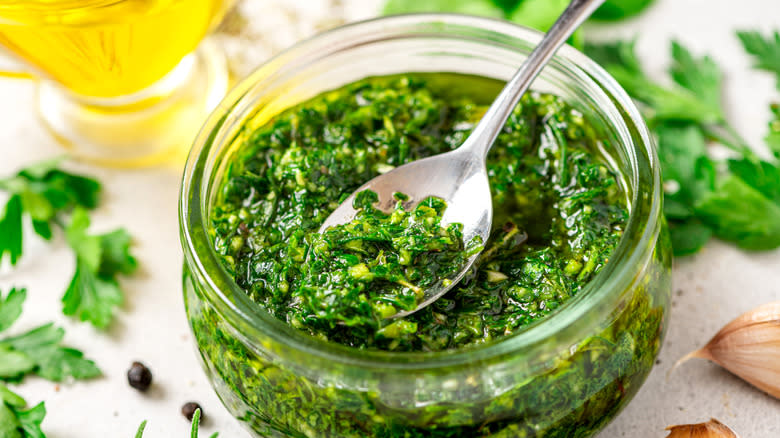
Chimichurri sauce is like a party in a bowl. This South American condiment is filled with fresh ingredients, including parsley, garlic, chili, oil, and vinegar. By the ingredient list alone, you may be able to draw some similarities between chimichurri and pesto, but it's important to note that the former comes with a bright, acidic component that gives it a bit more life. It's also easy to customize with herbs; swap the parsley with mint or cilantro to slightly alter its flavor profile.
The key to making flavorful chimichurri meatballs, besides pairing the herbs in the sauce with the profile of your meatballs, is to make sure you allot enough time for the flavors to meld together. This sauce works as a great pairing for plain pasta and meatballs and can be used for vegetarian, pork, beef, or poultry-based balls.
Sage Brown Butter Sauce
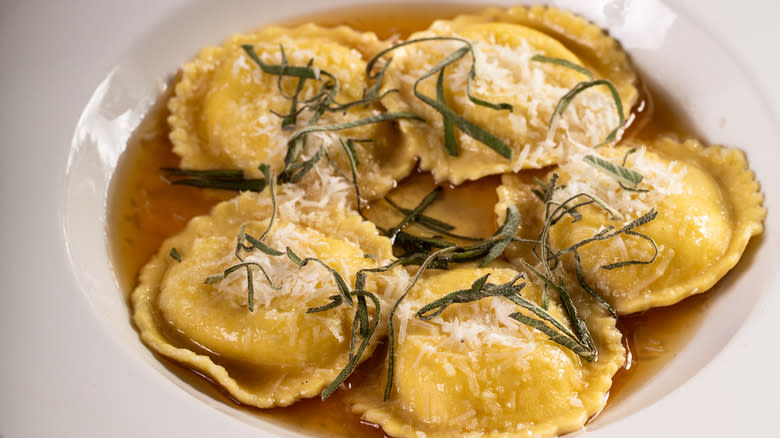
If you are whipping up a batch of ravioli, the first sauce you reach for shouldn't be marinara; it should be sage-infused brown butter sauce. The same can be said for meatballs, which really play off the toasty, buttery notes and the mouthfeel of the sauce. The sage is just an extra texture and flavor perk -- one that will play off the seasonings you add to the meatballs.
To make your sage brown butter, you'll want to cook down the butter and the fresh sage leaves until you can smell the nutty aroma from the pan and the leaves start to crisp up on the edges. It's important to note that the sauce is rather rich, so you won't need to douse your entire batch of meatballs in it. Toss it with the pasta first and add a little drizzle of sauce on top.
Enchilada Sauce
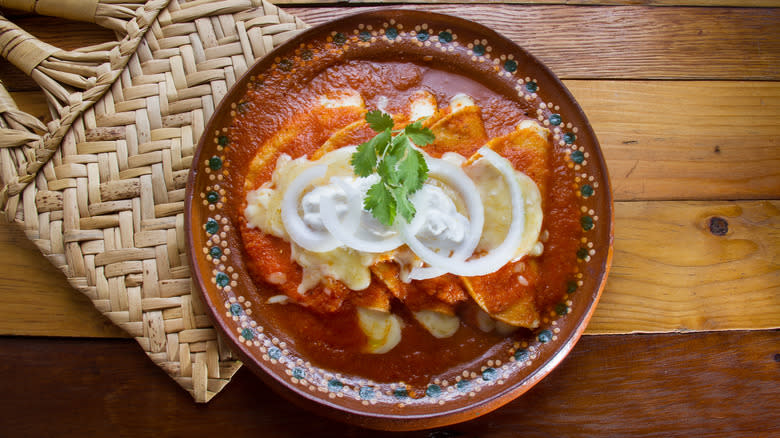
If you like the taste and smoky notes of chile peppers, you'll absolutely love enchilada sauce. Not only is it the perfect base for smothering tortillas in, but you can also use canned enchilada sauce for other things, like meatballs. The meatballs will really benefit from the bright, piquant notes of this sauce.
Granted, enchilada sauce can be spicy. So, if you like a smoother and less tomato-forward taste, you can always start with a cream sauce base and incrementally add the enchilada sauce until it reaches your desired flavor profile. Or, swap in different chile peppers to reach a comfortable heat level. Guajillo and ancho chiles lend themselves well to a red enchilada sauce, but you can also add in jalapeños for a milder flavor with less dark, smoky notes.
Curry Sauce
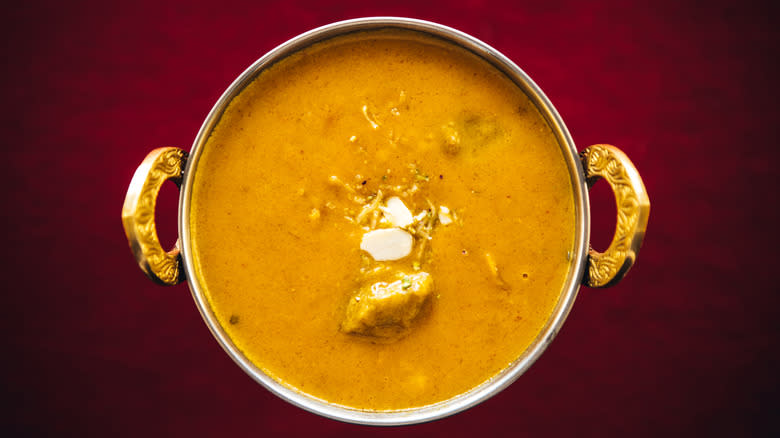
We can always appreciate a good curry, especially when it's a cold, blustery day and all we want to do is curl up with a good book. If you have a leftover curry in your fridge, now is the time to put it to use and spice up your meatballs.
You'll want to start with a curry with very few hunks of vegetables or meat in it. A vegetable coconut curry would be the perfect fit; it gets its creaminess from the coconut milk and its seasoning from a medley of turmeric, coriander, cumin, and mild curry powder (although you could turn up the heat with something spicier). The curry could complement a variety of meats, but it would make an especially compelling pairing for a quinoa-based vegetarian "meatball" that otherwise lacks a punchy flavor.
Mushroom Gravy
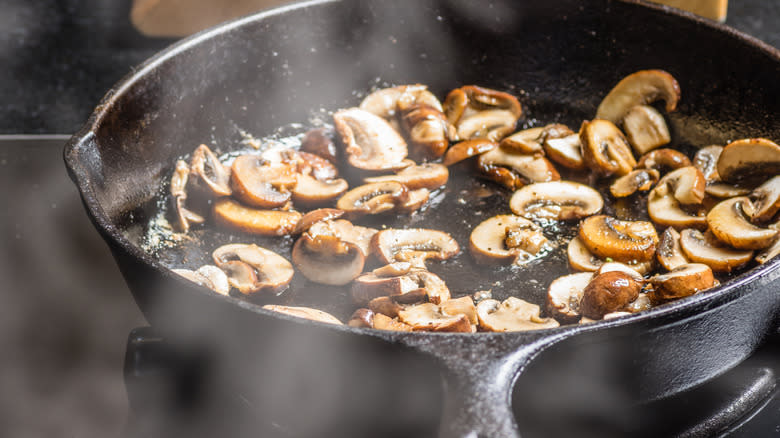
This is your sign to start putting mushrooms in your meatballs. And no, we're not just talking about adding them to a vegetarian or vegan version but rather all meatballs. They're full of umami flavor and can add a toothsome texture that will take any type of meatball, whether pork, beef, or plant-based, to the next level.
Mushroom gravy is an easy way to add extra umami flavor to your meatballs. Our recipe doesn't just stop with the meatballs, though; it also adds some soy sauce, miso paste, and Worcestershire sauce to amp up the savoriness. You'll want to cook down the gravy until it's thick and reduced before smothering your meatballs in it.
Mushroom gravy can be heavy, especially when paired with dense meatballs. You can always try to add some extra herbs to the sauce, like thyme and rosemary, to help balance out the heartiness.
Caramelized Onion Sauce
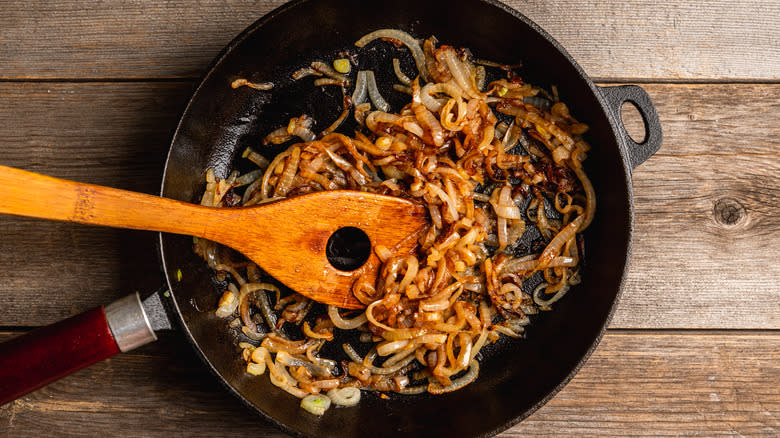
There's so much to love about caramelized onions. The cooking process helps bring out sweeter flavor notes that make these alliums more approachable. Plus, sautéing the onions in a pan will soften the texture and flavor significantly, thus eliminating the sharp bite of the raw onion.
You can start making this sauce for your meatballs by adding your caramelized onions to a pan with oil. The cooking time takes a while (up to 45 minutes) before you can add in other ingredients like brown sugar and balsamic vinegar. Once you're ready to serve, add some butter and parmesan to the party to make it a wholesome sauce perfect for serving with pasta. This caramelized onion pasta recipe is the perfect pairing for a classic Italian beef meatball, but we could also see getting barbecue sauce involved for a unique take on a pulled pork meatball.
Teriyaki Sauce

Teriyaki sauce and meatballs are not an unfamiliar pairing. The sweet and salty notes of the sauce pair well with an array of beef and pork dishes, so it's not odd to see them hanging out together in a recipe for a party-ready plate of meatballs.
You only need a trio of ingredients for a teriyaki sauce base: soy sauce, honey, and rice wine or mirin. Or, you can find the sauce in the Asian foods aisle of your local grocery store. But, customizing the sauce will allow you to add extra ingredients and aromatics, like a squeeze of ginger or garlic paste.
The honey will make these meatballs especially sticky, so you'll want to have toothpicks in tow. Alternatively, you can place your meatballs in a lettuce wrap for a less messy eating experience.
Peanut Sauce

We can't underscore how delicious peanut sauce is. Chicken satay and spring rolls wouldn't be complete without a side of the deliciously salty, creamy spread. It's important to note that while peanut butter makes up the bulk of a peanut sauce, there are other ingredients that give it a distinctively Asian flair; some recipes will include ginger, garlic, fish sauce, and soy sauce to add extra aromatic, salty, or umami notes. These extras also have an important job; making the sauce thin enough to dip and spread on noodles -- or meatballs.
You can't pair any old meatball with peanut sauce. The sauce needs to take center stage, so you're better off using a protein that can sit in the back -- like chicken, turkey, or a plant-based ball. You'll also need to deflect some of the flavor from the heavy peanut sauce with some vegetables. Adding spring onions to your meatballs, for example, can help give them a fresh, lighter feel that juxtaposes the sauce.
Piri-Piri Sauce
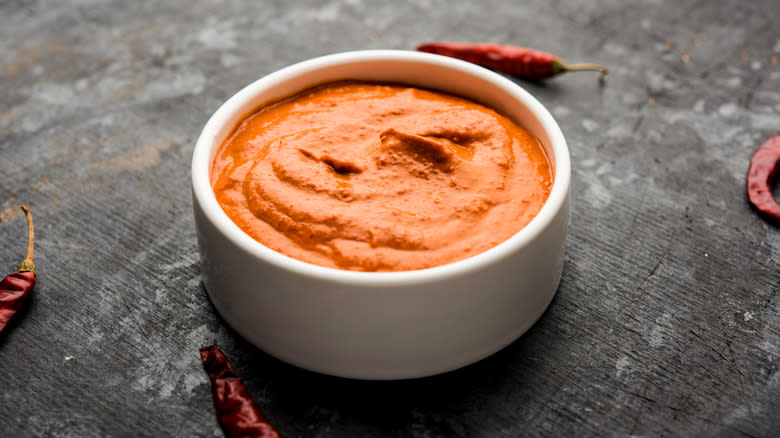
Piri-piri is a unique sauce that was seemingly made for folks who love all things hot and spicy. The sauce gets its piquant flavor from African bird's eye chilis, which are blended into the base, while aromatics like garlic, oil, vinegar, and herbs help round out the profile. The exact recipe varies based on who's making it, and it can be easily tailored to fit a more mild-preferring palate.
Piri-piri is most commonly paired with chicken, but there's no reason why you can't experiment with an array of other proteins in your meatballs. If you aren't a fan of a sauce that's this warm, you can always integrate your piri-piri into a classic marinara sauce or go for a neutral, cream-based one with a drizzle of piri-piri on top.
Shawarma Sauce
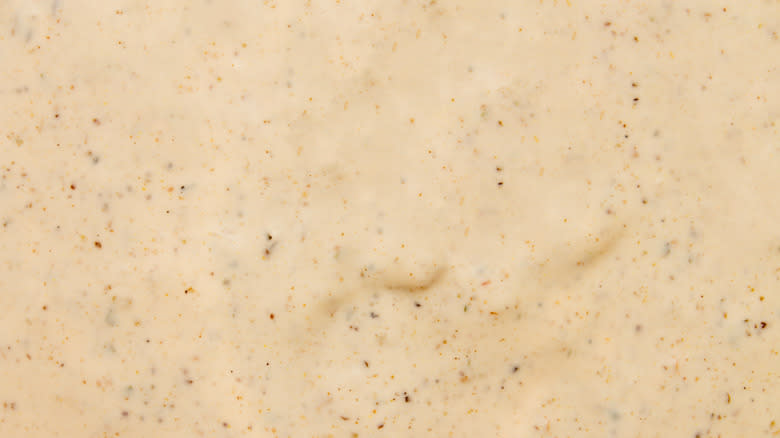
Shawarma sauce is essentially designed to complement meats. This white sauce is common on the Mediterranean sandwich (or wrap, depending on how you look at it), but you can also use it as a dip for veggies or as a schmear on your lunchtime sando of choice. The base is made with Greek yogurt and mayonnaise and flavored with lemon juice, fresh garlic, and seasonings. Think of it as aioli's even cooler cousin.
Many shawarma sauce recipes will also incorporate tahini (sesame paste) into the mix to give a thicker texture and subtly nutty flavor. You may also see Mediterranean spices like sumac and za'atar thrown in there. We recommend pairing shawarma sauce with a veggie-based meatball or one made with quinoa. The vegetal flavors of these meatballs can really play off the nutty and creamy notes of the sauce. Lamb could also be another delicious pairing for this unique sauce.
Grape Jelly Sauce

If you've never had grape jelly meatballs, you might be a little suspicious about how this pairing could work. But grape jelly and meatballs have been a favorite much longer than you might expect. The first recipes featuring this dynamic duo were published in entertainment cookbooks in the '60s.
The original, and modern, interpretations of this recipe cut the grape jelly with a tomato-chili sauce to help quell some of the sweetness. Many folks will stick to using a basic chili sauce, rather than an Asian sauce brimming with many spicy notes that can upset the subtle sweetness of the grape jelly. You can also mix and match from there with different hot sauces to bring the heat up to your liking.
Grape jelly meatballs make for a great party appetizer. But like many of the other saucy interpretations on this list, you'll want to be sure to pack toothpicks alongside your slow cooker; things may get sticky!
Red-Eye Gravy
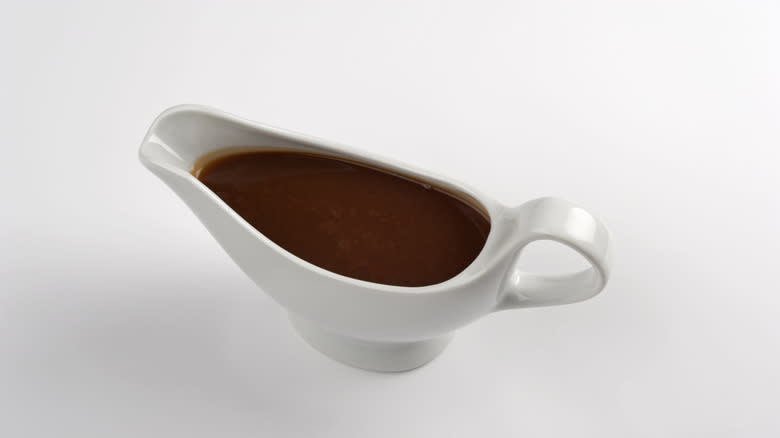
Red-eye gravy is a standard gravy recipe taken to the next level. It's traditionally made with ham drippings and seasoned with strong coffee. You can also add a sprinkle of light brown sugar to take the salty edge off the red-eye gravy. And if you're speculative about how the coffee would work in this recipe, we assure you that it's a magical combination that you have to taste to believe.
The best thing about coating your meatballs in a red-eye gravy sauce is that you already have the drippings from the meat to use as the base. It won't taste the same as if you used ham, but you can get away with it if you use a pork meatball instead. The sharpness of the coffee can stand up to a robustly flavored meatball just as well as one that needs a little bit more assistance in the flavor department.
Cream Sauce

When you think of meatballs, your mind likely immediately goes to the Italian ones swirling around in a mop of red sauce. Or, you think of another variety: classic Swedish meatballs. These meatballs, which are the highlight of any visit to an IKEA store, are often served with a side of cream sauce. Not only does the cream soak through the pork and beef ball, but it also adds flavor to the mashed potatoes underneath and mellows out the lingonberry jam served along with it.
We get it, you might be hesitant to pair an already rich meatball with a decadent cream sauce. But the phrase "cream sauce" opens up a ton of doors to experiment with different ingredients that can add freshness to your dish. Even a sprinkle of freshly ground black pepper or sprigs of rosemary and tarragon can add some much-needed flair to your dish.
Read the original article on Tasting Table


